Part 1 of 3: Establishing House Drink Recipes
A bartender makes a good drink with originality, panache, speed and skill - but a great drink starts with the boss. You determine the drink menu, you determine the recipes to be used and you set the price and make the rules. Your staff just follows your lead. In many bars, it's left to individual members of staff to know the "standard" formulas for cocktails and mixed drinks. Everyone is supposed to know that a Tequila Sunrise has one shot of tequila, right? Or is it two? Maybe it's a shot and a half... Profits are too hard won to just throw away alcohol when your staff crosses their wires about your drink recipes. Some easy steps to ensuring standardization of your house recipes include:
- Recipe lists. Make sure when you take on new staff they receive detailed recipe lists to take home and look over before they start their first shift. It doesn't cost you a lot to photocopy a few pages of text and give them to your staff, so make sure there's no excuse for them not to know as much as they can before they start mixing on your dime.
- Recipes on display. Ensure that there are either laminated index cards or recipes listed behind the bar at all times so that any member of staff - even emergency fill-ins and temps - can see exactly what is needed to prepare each drink - no more, no less. Below is an example of a recipe card and the information it should contain:

- Cocktail menus. When you leave cocktail menus on tables, make sure that each one shows exactly what is in the drink - not just the ingredients, but the ounce amounts of each. This will not only serve as a more informative drink menu to your customers, but will also allow them to more accurately measure what they've consumed over the course of the night.
- Premium ingredients. If you use premium or middle-shelf ingredients in your cocktails, make sure that your cocktail menus make a point of that fact by showing the brands used. There's no point in hiding the fact that your base spirits and liqueurs are of a higher quality than those of your competition, especially because your liquor distributor might chip in for some of the cost of printing if they're being marketed in your literature in this fashion.
- Accuracy. Make certain that the cocktail and mixed-drink recipes give a clear indication of what glass is to be used, what garnish should be used, for how long and on what setting any blended drink should be blended and what brands of alcohol should be used for their creation. If you leave anything out, you can bet someone will get it wrong - and with alarming regularity.
- Bartending recipe computer programs. For example, Interworlds Software's "BarBack for Windows" can tell your staff how to create a drink even if a customer asks for something ridiculously obscure. BarBack includes over 10,000 different drink recipes, as well as information on glassware, ingredients, mixing methods and garnishes. Rather than taking away from the skills of your staff, insightful programs such as these actually complement their skills to ensure your customers get exactly what they want in the quickest possible time. BarBack can be downloaded at www.barback.com .
This article is an excerpt from the Food Service Professional Guide to Bar & Beverage Operation, authored by Chris Parry, published by Atlantic Publishing Company. This excerpt has been reprinted with permission of the publisher. To purchase this book go to:
Atlantic Publishing Company
Amazon.com


